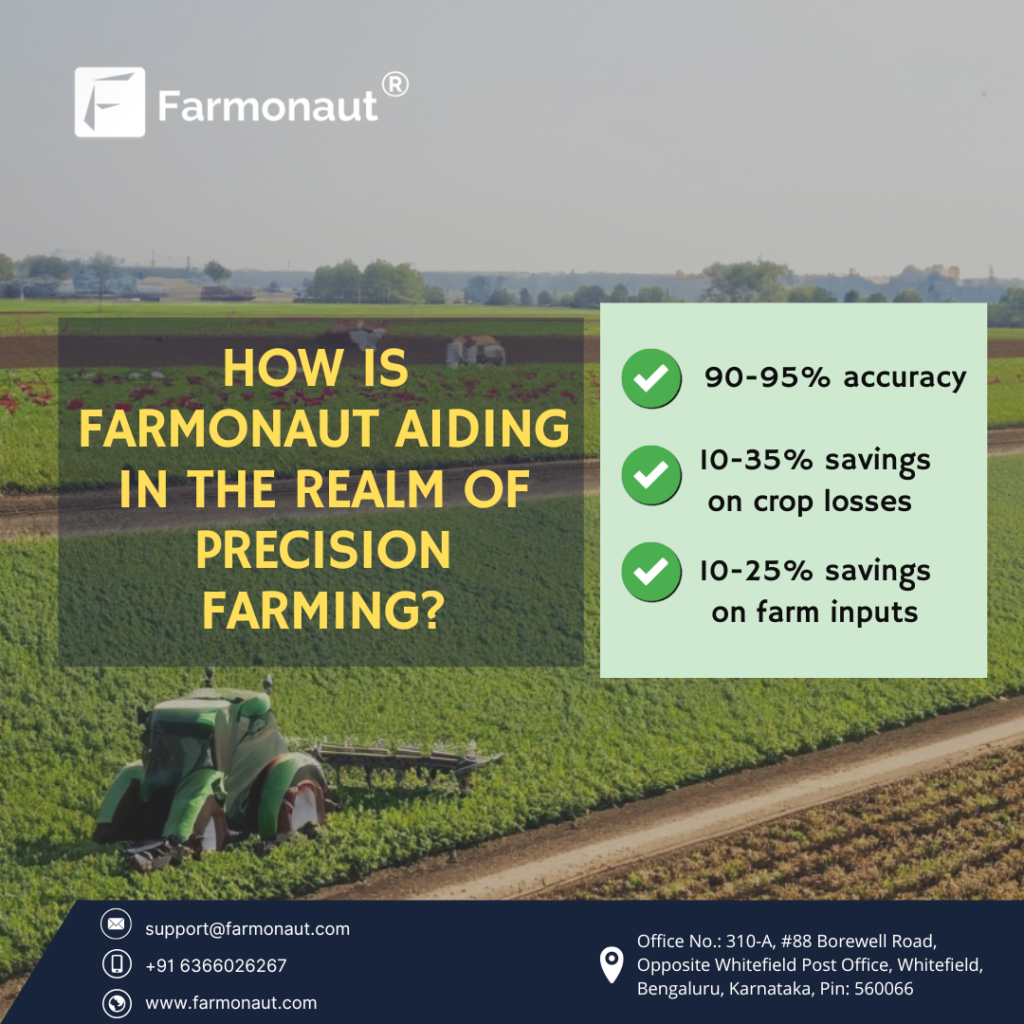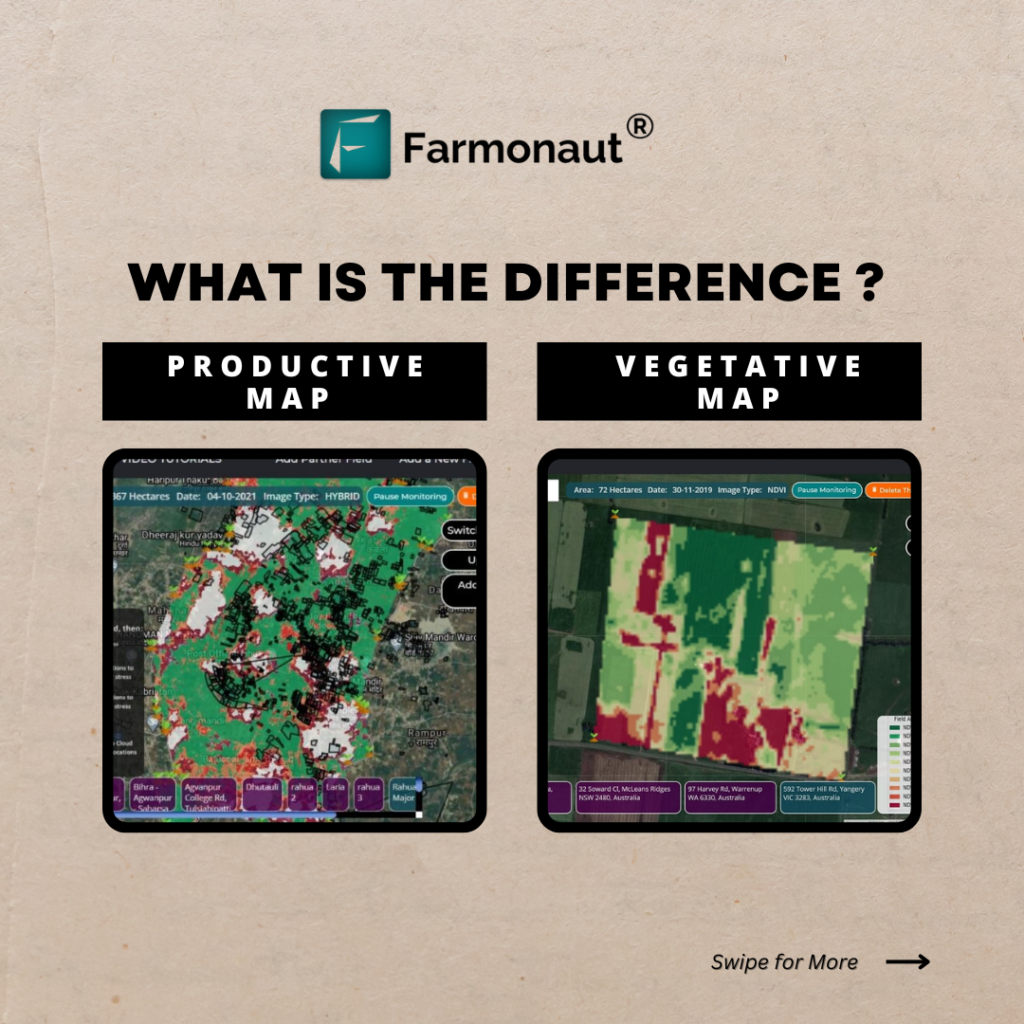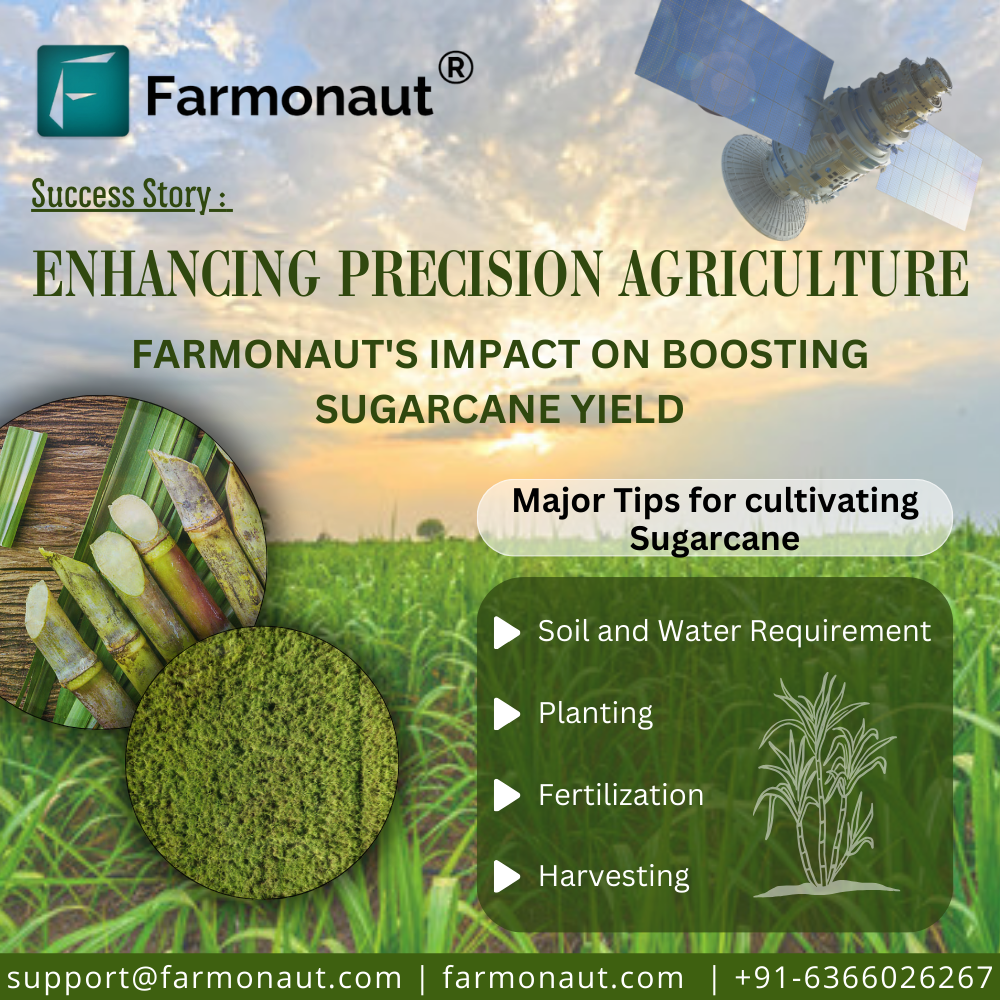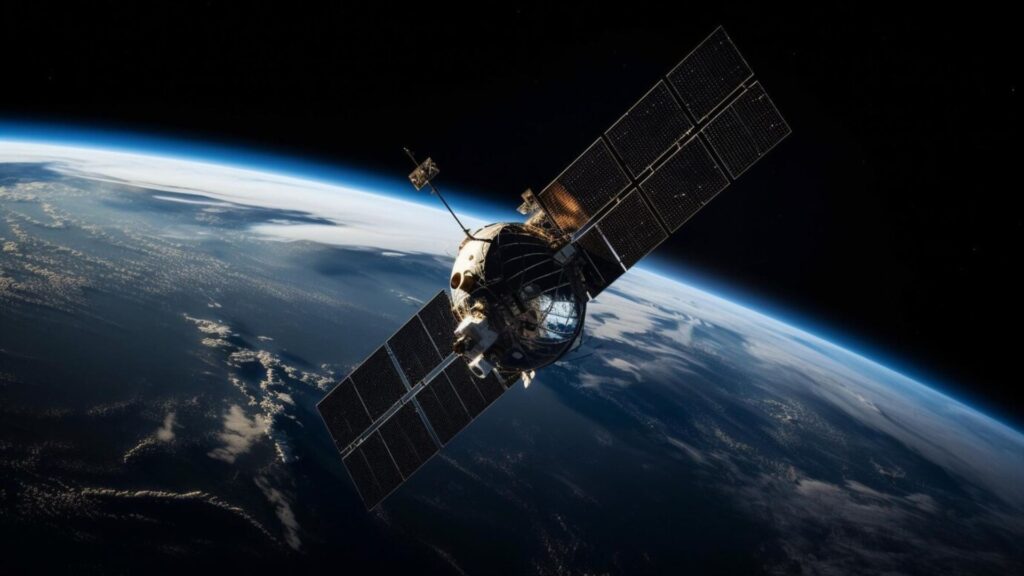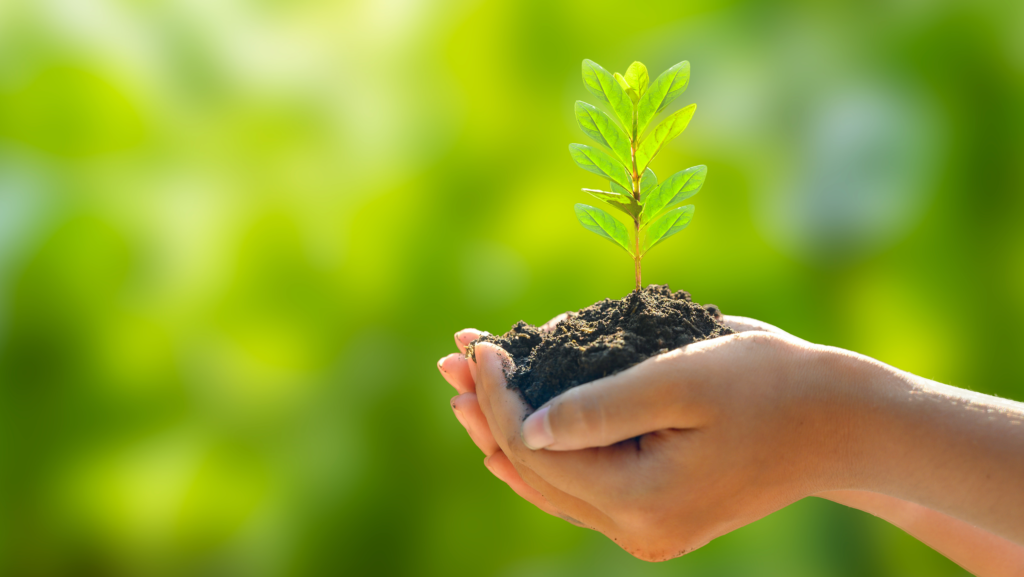Revolutionizing Agriculture: How Satellite Monitoring is Changing the Game for Small Farmers

In the ever-evolving world of agriculture, technology continues to play a pivotal role in enhancing productivity, sustainability, and profitability. At Farmonaut, we’re excited to share a groundbreaking development that’s set to transform the way small farmers manage their fields. Satellite monitoring, once considered a tool exclusively for large-scale operations, is now accessible and affordable for farmers with fields as small as 5 acres or less.
The Game-Changing Affordability of Satellite Monitoring
We’re thrilled to announce that the cost of one month of satellite monitoring is now less than the price of a single bottle of fertilizer or chemical. This remarkable affordability breakthrough means that even small-scale farmers can harness the power of advanced technology to optimize their agricultural practices.
To put this into perspective, let’s consider the following comparison:
- Average cost of a bottle of fertilizer: $20-$30
- Cost of one month of satellite monitoring: Less than $20
This cost-effectiveness opens up a world of possibilities for small farmers who previously may have thought such technology was out of reach.
The Power of Satellite Monitoring in Agriculture
Satellite monitoring is a cornerstone of precision agriculture, allowing farmers to gain valuable insights into their fields without the need for expensive on-ground equipment or time-consuming manual inspections. Here’s how it works:
- Satellites orbiting the Earth capture high-resolution images of agricultural land.
- These images are processed using advanced algorithms and remote sensing technology.
- The processed data provides farmers with crucial information about their crops, soil, and overall field health.
Benefits of Satellite Monitoring for Small Farmers
By adopting satellite monitoring, small farmers can enjoy numerous benefits that were once reserved for larger operations:
- Improved Crop Health: Detect issues early and take proactive measures.
- Optimized Resource Use: Apply water, fertilizers, and pesticides more efficiently.
- Increased Yields: Make data-driven decisions to maximize productivity.
- Cost Savings: Reduce waste and optimize input costs.
- Time Efficiency: Monitor fields remotely, saving time on manual inspections.
- Environmental Sustainability: Minimize the environmental impact of farming practices.
Farmonaut: Making Satellite Monitoring Accessible
At Farmonaut, we’re committed to democratizing access to advanced agriculture technology. Our platform leverages cutting-edge satellite technology and artificial intelligence to provide farmers with actionable insights about their fields.
Here’s how Farmonaut is making a difference:
- User-Friendly Mobile App: Access field data anytime, anywhere.
- Affordable Pricing: Plans tailored for small farmers.
- Comprehensive Insights: From crop health to weather forecasts.
- Expert Support: Guidance on interpreting and acting on data.
To start monitoring your agricultural fields, simply update your Android app or download it from the Google Play Store. iOS users can find our app on the App Store.
Comparing Farmonaut’s Satellite System to Drone and IoT-based Monitoring
| Feature | Farmonaut Satellite System | Drone-based Monitoring | IoT-based Monitoring |
|---|---|---|---|
| Coverage Area | Unlimited | Limited by flight time and regulations | Limited by sensor placement |
| Frequency of Data Collection | Regular intervals (e.g., daily, weekly) | As needed, weather-dependent | Continuous |
| Initial Investment | Low | High (drone purchase, training) | Medium to High (sensors, network setup) |
| Operational Complexity | Low (user-friendly app) | High (requires skilled operator) | Medium (requires maintenance) |
| Data Processing | Automated, AI-driven | Often requires manual processing | Automated, but limited scope |
The Future of Smart Farming
The integration of satellite monitoring into small-scale farming operations marks a significant milestone in the evolution of smart farming. As technology continues to advance, we can expect even more sophisticated tools and techniques to emerge, further enhancing the efficiency and sustainability of agriculture.
Some future trends we’re excited about include:
- Integration of satellite data with AI for predictive crop management
- Automated irrigation systems based on satellite-derived soil moisture data
- Blockchain integration for improved traceability and transparency in the food supply chain
- Advanced weather forecasting models for better risk management
Getting Started with Farmonaut
Ready to take your farming operations to the next level? Here’s how you can get started with Farmonaut:
- Download the Farmonaut app from the Google Play Store or App Store.
- Create an account and verify your email.
- Add your field by drawing its boundaries on the map.
- Choose your subscription plan based on your field size and monitoring needs.
- Start receiving regular updates and insights about your field!
For developers interested in integrating our satellite data into their own applications, check out our API documentation.
Pricing Plans
We offer flexible pricing plans to suit farms of all sizes. Here’s our current pricing table:
The Environmental Impact of Precision Agriculture
Beyond the economic benefits for farmers, the widespread adoption of satellite monitoring and precision agriculture techniques has significant positive environmental implications:
- Reduced Water Usage: By providing accurate soil moisture data, satellite monitoring helps farmers use water more efficiently, crucial in water-scarce regions.
- Minimized Chemical Runoff: Precise application of fertilizers and pesticides reduces the amount of chemicals that end up in waterways.
- Soil Conservation: Better management practices informed by satellite data help preserve soil health and reduce erosion.
- Biodiversity Protection: Optimized use of chemicals and water helps maintain local ecosystems and protect wildlife.
- Reduced Carbon Footprint: Efficient use of machinery and resources leads to lower greenhouse gas emissions from agricultural activities.
The Role of Satellite Monitoring in Food Security
As the global population continues to grow, ensuring food security becomes increasingly crucial. Satellite monitoring plays a vital role in this challenge by:
- Enabling early warning systems for crop failures or natural disasters
- Providing data for more accurate crop yield predictions
- Helping farmers in developing countries increase their productivity
- Supporting sustainable intensification of agriculture to meet growing food demands
- Facilitating better distribution of resources and aid in times of food scarcity
Integrating Satellite Monitoring with Other Technologies
While satellite monitoring is powerful on its own, its potential is further amplified when integrated with other cutting-edge technologies:
1. Artificial Intelligence and Machine Learning
AI algorithms can analyze satellite imagery to detect patterns and anomalies that might be missed by human observers. This can lead to more accurate predictions of crop yields, pest outbreaks, and optimal harvest times.
2. Internet of Things (IoT)
Combining satellite data with ground-based IoT sensors can provide a more comprehensive view of field conditions, allowing for even more precise management decisions.
3. Blockchain Technology
Integrating satellite monitoring data with blockchain can enhance traceability in the food supply chain, ensuring transparency from farm to table.
4. Autonomous Machinery
Satellite data can guide autonomous tractors and drones for tasks like planting, spraying, and harvesting, further optimizing farm operations.
The Global Impact of Accessible Satellite Monitoring
The democratization of satellite monitoring technology has far-reaching implications for global agriculture:
- Empowering Smallholder Farmers: In many developing countries, smallholder farmers produce the majority of food. Access to satellite monitoring can significantly improve their productivity and livelihoods.
- Addressing Climate Change: As climate patterns become more unpredictable, satellite monitoring helps farmers adapt their practices to changing conditions.
- Reducing Food Waste: Better crop management leads to less waste in the field and throughout the supply chain.
- Promoting Sustainable Practices: Data-driven farming encourages more sustainable use of resources, benefiting both farmers and the environment.
- Enhancing Global Food Security: Improved agricultural productivity and resilience contribute to more stable food supplies worldwide.
The Future of Farmonaut and Satellite Monitoring
At Farmonaut, we’re constantly innovating to bring even more value to farmers. Some of our upcoming features and focus areas include:
- Enhanced AI Predictions: We’re developing more sophisticated AI models to provide even more accurate predictions and recommendations.
- Integration with Farm Management Software: We’re working on partnerships to integrate our satellite data with popular farm management platforms for a seamless user experience.
- Expanded Crop Coverage: We’re continually expanding our database to provide tailored insights for an even wider range of crops.
- Advanced Weather Forecasting: We’re improving our weather prediction models to help farmers better prepare for extreme weather events.
- Community Features: We’re developing tools to allow farmers to share insights and best practices within the Farmonaut platform.
Frequently Asked Questions (FAQ)
Q: How accurate is satellite monitoring compared to on-ground observations?
A: Satellite monitoring can be highly accurate, often detecting issues before they’re visible to the naked eye. However, it’s best used in conjunction with periodic ground-truthing for optimal results.
Q: How often is the satellite data updated?
A: Our standard plans offer weekly updates, but we also have options for daily updates in some regions. The frequency can vary based on satellite availability and weather conditions.
Q: Can satellite monitoring work for all types of crops?
A: While satellite monitoring is effective for a wide range of crops, its efficacy can vary. It’s particularly useful for field crops but may have limitations for some greenhouse or indoor farming operations.
Q: Do I need special equipment to use Farmonaut’s satellite monitoring service?
A: No special equipment is needed. All you need is a smartphone or computer with internet access to use our platform.
Q: How does cloud cover affect satellite monitoring?
A: While heavy cloud cover can interfere with optical satellite imagery, we use a combination of different satellite types and advanced algorithms to minimize this impact.
Q: Is my farm data secure with Farmonaut?
A: Yes, we take data security very seriously. All farm data is encrypted and stored securely, and we never share individual farm data without explicit permission.
Q: Can Farmonaut’s satellite monitoring replace the need for field visits?
A: While satellite monitoring significantly reduces the need for frequent field visits, it’s still important to physically inspect your fields periodically. Our technology is designed to complement, not replace, good farming practices.
Conclusion: Embracing the Future of Agriculture
The advent of affordable satellite monitoring for small farms marks a significant milestone in the democratization of agricultural technology. At Farmonaut, we’re proud to be at the forefront of this revolution, making precision agriculture accessible to farmers of all scales.
By leveraging the power of satellite technology, AI, and data analytics, we’re empowering farmers to make more informed decisions, optimize their resources, and increase their productivity while promoting sustainable practices. The future of farming is here, and it’s more accessible than ever before.
We invite you to join us on this exciting journey. Whether you’re a small farmer looking to optimize your operations, a developer interested in our API, or an agricultural enthusiast curious about the latest in farming technology, Farmonaut has something to offer you.
Ready to transform your farming practices? Download our app today and start your journey towards smarter, more efficient farming. Together, we can cultivate a more sustainable and prosperous future for agriculture.
Happy Farming!


